How to install the app on iOS
Follow along with the video below to see how to install our site as a web app on your home screen.
Note: This feature may not be available in some browsers.
You are using an out of date browser. It may not display this or other websites correctly.
You should upgrade or use an alternative browser.
You should upgrade or use an alternative browser.
Western China - news and development
- Thread starter ahojunk
- Start date
ahojunk
RETIRED INTL MOD

- Joined
- Nov 17, 2014
- Messages
- 5,118
- Reaction score
- 6
- Country
- Location
China-Eurasia Expo closes, 18 bln USD contracts signed
2016-09-26 13:12 | Xinhua | Editor: Xu Shanshan
A total of 18 billion U. S. dollars worth of contracts were signed during the fifth China-Eurasia Expo in Urumqi, northwest China's Xinjiang Uygur Autonomous Region.
During the expo, held from September 20 to 25, contracts were signed covering areas such as science, agriculture, mineral resources, energy, manufacturing and finance. A total of 16 corporate finance cooperation projects were signed.
Delegates from 57 countries and regions and six international organizations attended the expo, along with 3,500 professional purchasers. A total of 2,192 companies, including 418 overseas firms, took part in the expo.
The previous expo saw 6 billion U.S. dollars worth of foreign trade contracts signed with Chinese companies.
Li Jingyuan, head of the expo's secretariat, said the expo further strengthened Xinjiang's overseas cooperation, and played an increasingly important role in promoting the Silk Road Economic Belt construction.
2016-09-26 13:12 | Xinhua | Editor: Xu Shanshan
A total of 18 billion U. S. dollars worth of contracts were signed during the fifth China-Eurasia Expo in Urumqi, northwest China's Xinjiang Uygur Autonomous Region.
During the expo, held from September 20 to 25, contracts were signed covering areas such as science, agriculture, mineral resources, energy, manufacturing and finance. A total of 16 corporate finance cooperation projects were signed.
Delegates from 57 countries and regions and six international organizations attended the expo, along with 3,500 professional purchasers. A total of 2,192 companies, including 418 overseas firms, took part in the expo.
The previous expo saw 6 billion U.S. dollars worth of foreign trade contracts signed with Chinese companies.
Li Jingyuan, head of the expo's secretariat, said the expo further strengthened Xinjiang's overseas cooperation, and played an increasingly important role in promoting the Silk Road Economic Belt construction.
JSCh
ELITE MEMBER

- Joined
- Jun 9, 2011
- Messages
- 13,235
- Reaction score
- 2
- Country
- Location
First Tibetan 'test tube baby' born
(People's Daily Online) 14:37, September 29, 2016
 The first "test tube baby" of Tibet Autonomous Region is born on Sept.24. (Photo/vtibet.com)
The first "test tube baby" of Tibet Autonomous Region is born on Sept.24. (Photo/vtibet.com)
At 3 p.m. on Sept. 24, the first "test tube baby" of Tibet Autonomous Region was born in Fukang Women's and Children's Hospital in Lhasa. The milestone signifies a major breakthrough for assisted reproductive technology in high-altitude environments, China News Service reported.
On July 25, 1978, the world's first test tube baby was born in the UK. Thirty-eight years later, Tibet has realized that accomplishment for itself. According to the hospital, the baby is male, weighing 2.69 kilograms. Both the baby and mother are doing well.
Wu Dong, an expert from Chengdu who provides technical support to the hospital, explained that due to factors such as decreased oxygen and lower air pressure, it has always been a challenge to apply the assisted reproduction techniques successful in other areas to women in the Qinghai-Tibet Plateau.
Wang Bin, founder of Fukang Women's and Children's Hospital, said that three years ago, the PLA Tibet Command General Hospital carried out excellent research on the application of assisted reproductive technology in high-altitude environments, which built a foundation for this most recent success. Fukang Women's and Children's Hospital is now the only hospital in Tibet with an assisted reproductive technology center.
"Many couples in Tibet want to have children through assisted reproductive technology. In the past, they had to travel a long distance to inland cities, facing economic and cultural pressure," Wang said. "Now that we have seen the first successful birth of a test tube baby in Tibet, Tibetan couples will have more choices in the future."
(People's Daily Online) 14:37, September 29, 2016

At 3 p.m. on Sept. 24, the first "test tube baby" of Tibet Autonomous Region was born in Fukang Women's and Children's Hospital in Lhasa. The milestone signifies a major breakthrough for assisted reproductive technology in high-altitude environments, China News Service reported.
On July 25, 1978, the world's first test tube baby was born in the UK. Thirty-eight years later, Tibet has realized that accomplishment for itself. According to the hospital, the baby is male, weighing 2.69 kilograms. Both the baby and mother are doing well.
Wu Dong, an expert from Chengdu who provides technical support to the hospital, explained that due to factors such as decreased oxygen and lower air pressure, it has always been a challenge to apply the assisted reproduction techniques successful in other areas to women in the Qinghai-Tibet Plateau.
Wang Bin, founder of Fukang Women's and Children's Hospital, said that three years ago, the PLA Tibet Command General Hospital carried out excellent research on the application of assisted reproductive technology in high-altitude environments, which built a foundation for this most recent success. Fukang Women's and Children's Hospital is now the only hospital in Tibet with an assisted reproductive technology center.
"Many couples in Tibet want to have children through assisted reproductive technology. In the past, they had to travel a long distance to inland cities, facing economic and cultural pressure," Wang said. "Now that we have seen the first successful birth of a test tube baby in Tibet, Tibetan couples will have more choices in the future."
ahojunk
RETIRED INTL MOD

- Joined
- Nov 17, 2014
- Messages
- 5,118
- Reaction score
- 6
- Country
- Location
I love news where the rural & mostly poor folks are helped. Most of them are located in the western regions.
========
Targeted measures in poverty alleviation launched in China's Qinghai
(Xinhua) 19:13, September 30, 2016
"Our life will get better and better", the 50-year-old Zhao Xuewen said while looking at his sheep on the hillside in Gezidong.
His situation was not so good only a few years ago. In 2012, Zhao suffered a fracture to his leg as he repaired his house. Unfortunately, his wife had three operations in the same year. The successive misfortunes subjected the man of the Hui ethnic group a heavy blow.
To help him to cope with the difficulty, local village committee listed Zhao as a low-income family. And the new rural cooperative medical care system provided 85 percent coverage for his medical expenses.
In 2015, as one targeted measure in poverty alleviation campaigns, local government invested one million yuan (about 150,000 U.S. dollars) to build a livestock-breeding center and buy cattle and sheep. On the recommendation of villagers, Zhao Xuewen became one of the two contractors of the livestock-breeding cooperative in Gezidong.
Thanks to his hard work, the annual income of Zhao's family exceeded 50,000 yuan (about 7,500 U.S. dollars). And the livestock-breeding cooperative also distributed dividends to other poverty-stricken families in the village. This year, Zhao enlarged his farming scale and expected a better income.
Targeted measures in poverty alleviation, including characteristic industry development and ecological environment protection, have been launched in Qinghai. According to the provincial bureau for poverty alleviation and development, about 110,000 people in Qinghai will be lifted out of poverty in 2016.

Zhao Xuewen feeds the cattle at a livestock-breeding cooperative in Gezidong Village of Zhamashi Township, Qilian County, northwest China's Qinghai Province, Sept. 28, 2016.

Zhao Xuewen tends sheep on the grassland in Gezidong Village of Zhamashi Township, Qilian County, northwest China's Qinghai Province, Sept. 27, 2016.

Zhao Fugui, son of Zhao Xuewen, feeds medicine to a sheep to control parasite at a livestock-breeding cooperative in Gezidong Village of Zhamashi Township, Qilian County, northwest China's Qinghai Province, Sept. 28, 2016.

Zhao Xuewen distributes feedstuff at a livestock-breeding cooperative in Gezidong Village of Zhamashi Township, Qilian County, northwest China's Qinghai Province, Sept. 28, 2016.

Zhao Xuewen feeds the cattle at a livestock-breeding cooperative in Gezidong Village of Zhamashi Township, Qilian County, northwest China's Qinghai Province, Sept. 28, 2016.

Zhao Xuewen handles feedstuff at a livestock-breeding cooperative in Gezidong Village of Zhamashi Township, Qilian County, northwest China's Qinghai Province, Sept. 28, 2016.

Zhao Xuewen welds a food trough at a livestock-breeding cooperative in Gezidong Village of Zhamashi Township, Qilian County, northwest China's Qinghai Province, Sept. 28, 2016.
========
Targeted measures in poverty alleviation launched in China's Qinghai
(Xinhua) 19:13, September 30, 2016
"Our life will get better and better", the 50-year-old Zhao Xuewen said while looking at his sheep on the hillside in Gezidong.
His situation was not so good only a few years ago. In 2012, Zhao suffered a fracture to his leg as he repaired his house. Unfortunately, his wife had three operations in the same year. The successive misfortunes subjected the man of the Hui ethnic group a heavy blow.
To help him to cope with the difficulty, local village committee listed Zhao as a low-income family. And the new rural cooperative medical care system provided 85 percent coverage for his medical expenses.
In 2015, as one targeted measure in poverty alleviation campaigns, local government invested one million yuan (about 150,000 U.S. dollars) to build a livestock-breeding center and buy cattle and sheep. On the recommendation of villagers, Zhao Xuewen became one of the two contractors of the livestock-breeding cooperative in Gezidong.
Thanks to his hard work, the annual income of Zhao's family exceeded 50,000 yuan (about 7,500 U.S. dollars). And the livestock-breeding cooperative also distributed dividends to other poverty-stricken families in the village. This year, Zhao enlarged his farming scale and expected a better income.
Targeted measures in poverty alleviation, including characteristic industry development and ecological environment protection, have been launched in Qinghai. According to the provincial bureau for poverty alleviation and development, about 110,000 people in Qinghai will be lifted out of poverty in 2016.
Zhao Xuewen feeds the cattle at a livestock-breeding cooperative in Gezidong Village of Zhamashi Township, Qilian County, northwest China's Qinghai Province, Sept. 28, 2016.
Zhao Xuewen tends sheep on the grassland in Gezidong Village of Zhamashi Township, Qilian County, northwest China's Qinghai Province, Sept. 27, 2016.
Zhao Fugui, son of Zhao Xuewen, feeds medicine to a sheep to control parasite at a livestock-breeding cooperative in Gezidong Village of Zhamashi Township, Qilian County, northwest China's Qinghai Province, Sept. 28, 2016.
Zhao Xuewen distributes feedstuff at a livestock-breeding cooperative in Gezidong Village of Zhamashi Township, Qilian County, northwest China's Qinghai Province, Sept. 28, 2016.
Zhao Xuewen feeds the cattle at a livestock-breeding cooperative in Gezidong Village of Zhamashi Township, Qilian County, northwest China's Qinghai Province, Sept. 28, 2016.
Zhao Xuewen handles feedstuff at a livestock-breeding cooperative in Gezidong Village of Zhamashi Township, Qilian County, northwest China's Qinghai Province, Sept. 28, 2016.
Zhao Xuewen welds a food trough at a livestock-breeding cooperative in Gezidong Village of Zhamashi Township, Qilian County, northwest China's Qinghai Province, Sept. 28, 2016.
ahojunk
RETIRED INTL MOD

- Joined
- Nov 17, 2014
- Messages
- 5,118
- Reaction score
- 6
- Country
- Location
Kunming is a good place to visit. The climate and weather is also tourist friendly.
========
Tourists enjoy gigantic flower cake in Kunming
(People's Daily Online) 13:24, September 30, 2016
A flower cake weighing 400 kilograms and measuring 2.28 meters in diameter debuts in Kunming on Sept. 29.
The cake was later shared by a group of tourists.
Flower cake is a specialty of Yunnan province. Its filling is made with edible roses.

Nice picture of the flower cake that weighs 400 kilograms and measures 2.28 meters in diameter in Kunming on Sept. 29. Flower cake is a specialty of Yunnan province. Its filling is made with edible roses. (Photo/CNS)
I like the colorful costumes of the Yunnan ethnic minorities.

Cutting the cake

Sharing the cake with tourists.

Enjoying the cake.
========
Tourists enjoy gigantic flower cake in Kunming
(People's Daily Online) 13:24, September 30, 2016
A flower cake weighing 400 kilograms and measuring 2.28 meters in diameter debuts in Kunming on Sept. 29.
The cake was later shared by a group of tourists.
Flower cake is a specialty of Yunnan province. Its filling is made with edible roses.
Nice picture of the flower cake that weighs 400 kilograms and measures 2.28 meters in diameter in Kunming on Sept. 29. Flower cake is a specialty of Yunnan province. Its filling is made with edible roses. (Photo/CNS)
I like the colorful costumes of the Yunnan ethnic minorities.
Cutting the cake
Sharing the cake with tourists.
Enjoying the cake.
AndrewJin
ELITE MEMBER

- Joined
- Feb 23, 2015
- Messages
- 14,904
- Reaction score
- 23
- Country
- Location
Freshly baked flower cake is very delicious.Kunming is a good place to visit. The climate and weather is also tourist friendly.
========
Tourists enjoy gigantic flower cake in Kunming
(People's Daily Online) 13:24, September 30, 2016
A flower cake weighing 400 kilograms and measuring 2.28 meters in diameter debuts in Kunming on Sept. 29.
The cake was later shared by a group of tourists.
Flower cake is a specialty of Yunnan province. Its filling is made with edible roses.
View attachment 339409
Nice picture of the flower cake that weighs 400 kilograms and measures 2.28 meters in diameter in Kunming on Sept. 29. Flower cake is a specialty of Yunnan province. Its filling is made with edible roses. (Photo/CNS)
View attachment 339410
Cutting the cake
View attachment 339412
Sharing the cake with tourists.
I really enjoyed it when i traveled in Yunnan.
ahojunk
RETIRED INTL MOD

- Joined
- Nov 17, 2014
- Messages
- 5,118
- Reaction score
- 6
- Country
- Location
Tibet dams river for its costliest hydro project
2016-10-01 10:04 | Xinhua | Editor: Li Yan
Tibet on Friday blocked a tributary of the Yarlung Zangbo River as part of its most expensive hydro project.
The Lalho project on the Xiabuqu River in Xigaze, involves an investment of 4.95 billion yuan (740 million U.S. dollars), said Zhang Yunbao, head of the project's administration bureau.
The project was scheduled to be completed in 2019. Construction began in June 2014.
The project serves multiple purposes, including irrigation, flood control and power generation, said Zhang.
Its reservoir was designed to store up to 295 million cubic meters of water and help irrigate 30,000 hectares of farmland.
The farming area, which usually suffers from severe drought, is a major crop production base in Xigaze.
The project will have two power stations with a combined generation capacity of 42 megawatts. They are designed to generate 85 million kilowatt-hours of electricity each year.
2016-10-01 10:04 | Xinhua | Editor: Li Yan
Tibet on Friday blocked a tributary of the Yarlung Zangbo River as part of its most expensive hydro project.
The Lalho project on the Xiabuqu River in Xigaze, involves an investment of 4.95 billion yuan (740 million U.S. dollars), said Zhang Yunbao, head of the project's administration bureau.
The project was scheduled to be completed in 2019. Construction began in June 2014.
The project serves multiple purposes, including irrigation, flood control and power generation, said Zhang.
Its reservoir was designed to store up to 295 million cubic meters of water and help irrigate 30,000 hectares of farmland.
The farming area, which usually suffers from severe drought, is a major crop production base in Xigaze.
The project will have two power stations with a combined generation capacity of 42 megawatts. They are designed to generate 85 million kilowatt-hours of electricity each year.
JSCh
ELITE MEMBER

- Joined
- Jun 9, 2011
- Messages
- 13,235
- Reaction score
- 2
- Country
- Location
Women doctors defy male dominance in Tibetan medicines
Source: Xinhua | 2016-09-30 16:33:26 | Editor: huaxia
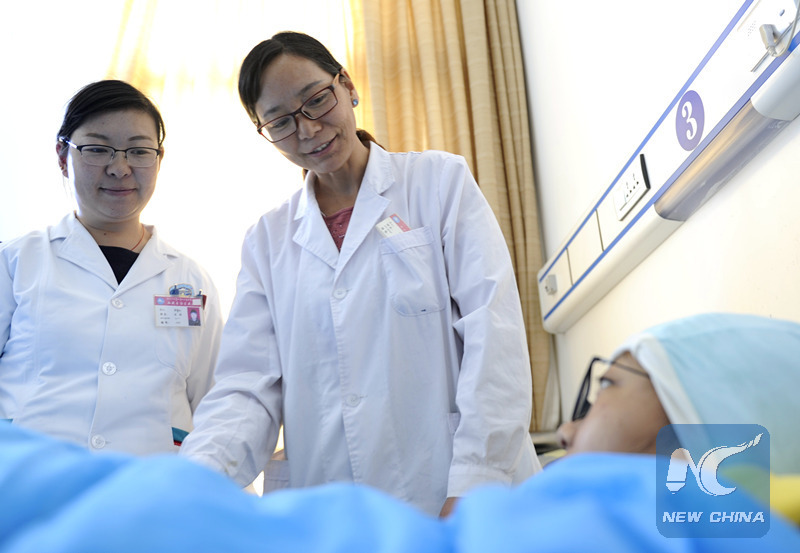 Lhaphun (middle) talks to a patient at Tibetan Hospital in Lhasa, southwest China's Tibet Autonomous Region, Sept. 20, 2016. (Xinhua/Jigme Dorje)
Lhaphun (middle) talks to a patient at Tibetan Hospital in Lhasa, southwest China's Tibet Autonomous Region, Sept. 20, 2016. (Xinhua/Jigme Dorje)
LHASA, Sept. 30 (Xinhua) -- Tibetan women, considered unsuitable to study and practice medicine for more than 3,000 years, are now playing an equal role to men in Tibetan medicine.
Lhaphun, a gynecologist with the Tibetan Hospital in Lhasa, said she was astonished to be admitted to the Tibet College of Tibetan Medicine (TCTM) 26 years ago as she was sure she would have to study Western medicine.
"In my mind, scripture halls were where Tibetan doctors were taught," recalled the 45-year-old doctor.
 Lhaphun works on a newborn at Tibetan Hospital in Lhasa, Sept. 20, 2016. (Xinhua/Jigme Dorje)
Lhaphun works on a newborn at Tibetan Hospital in Lhasa, Sept. 20, 2016. (Xinhua/Jigme Dorje)
MODERN EDUCATION BRINGS WOMEN DOCTORS
For thousands of years, knowledge and treatment of Tibetan medicine had been passed down in monasteries and the best doctors were often monks. Women rarely had the chance to learn medicine, and their roles were restricted to household chores and raising children.
In 1963, fifteen Tibetan women entered Lhasa's Men-Tsee-Khang -- a traditional Tibetan hospital founded in 1916 -- to begin formal medical study.
Women now make up half of the 800 physicians at the Tibetan Hospital in Lhasa. Of new students enrolled by the nearby Tibet College of Tibetan Medicine each year, almost a half are female.
Recalling her college life, Lhaphun said unlike traditional Dratsang (monastery schools) where lessons were given in dimly lit scripture halls, their classrooms were in modern buildings.
The routine monastic practice of chanting mantras was skipped, but classical works by ancient medical masters were memorized to obtain the basic theories and knowledge of Tibetan medicine.
Lhaphun and her classmates familiarized themselves with herbalism, grasping diagnosis and various therapies. In summer, they followed their instructors to learn about herbs in the mountains.
The most impressive course for Lhaphun was ethics. Thirty-one sections of Volume II of the Four Medical Tantras, an encyclopedia of Tibetan medicine dating back to the eighth century, are devoted to medical ethics.
"The best doctors should take all patients as their children and treat them equally. That makes the job noble," said Lhaphun.
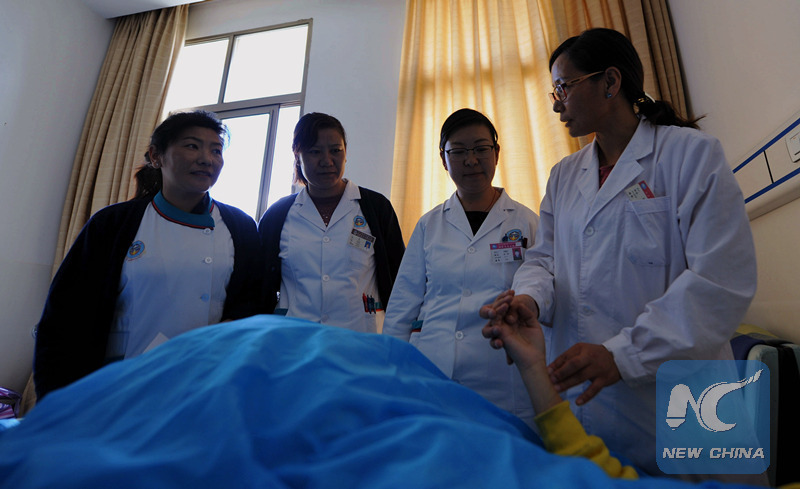 Lhaphun and her colleagues discuss the condition of a patient at Tibetan Hospital in Lhasa, Sept. 20, 2016. (Xinhua/Jigme Dorje)
Lhaphun and her colleagues discuss the condition of a patient at Tibetan Hospital in Lhasa, Sept. 20, 2016. (Xinhua/Jigme Dorje)
Tenzin Yangjen, 22, graduate of the West China School of Pharmacy at Sichuan University, joined the Tibetan Medicine Development and Research Institute at the Lhasa Hospital last year.
"It's no longer rare for women to study medicine in Tibet. Women doctors work in all departments of our hospital," she said.
PIONEERS OF MODERNITY OF TIBETAN MEDICINE
Describing her job as finding "secret" prescriptions in classical medical tantras and revitalizing them through modern technology, Tenzin Yangjen said her goal was to standardize Tibetan medicine as much as possible.
"For our generation, the mission is to bring Tibetan medicine to the world, and the key is standardization," she said.
 Lhaphun talks to a patient at Tibetan Hospital in Lhasa, Sept. 20, 2016. (Xinhua/Jigme Dorje)
Lhaphun talks to a patient at Tibetan Hospital in Lhasa, Sept. 20, 2016. (Xinhua/Jigme Dorje)
To reach that goal, Tenzin Yangjen and her colleagues have been working to standardize herbal products using modern extractive technology to turn traditional decoctions and pills to granules that are more popular in today's market.
Lhaphun has worked at the Lhasa hospital for 21 years. A primary task has been to find and rescue endangered therapies and explore ways to integrate them with modern medical science. For instance, her team uses modern equipment to conduct data analysis and correlate their findings with traditional urine and pulse diagnosis.
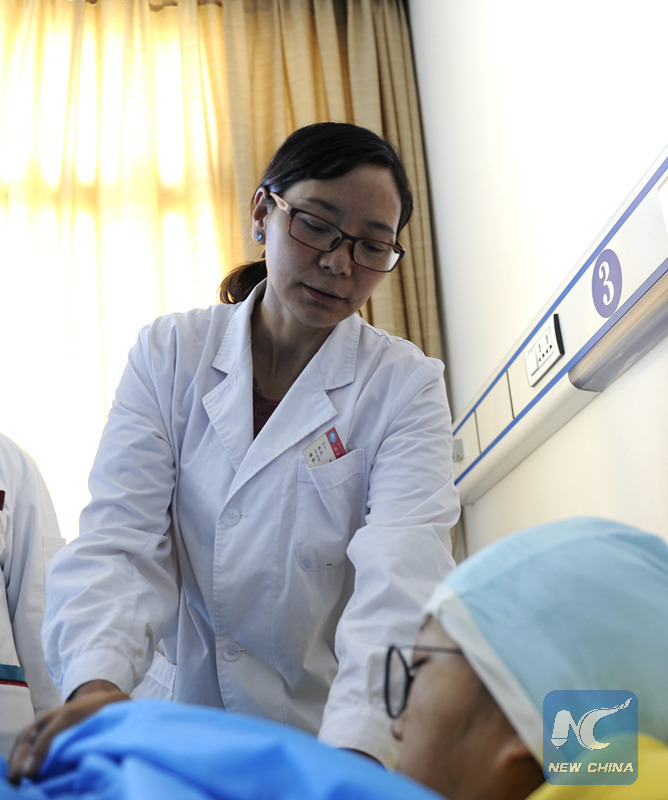 Lhaphun checks a patient at Tibetan Hospital in Lhasa, Sept. 20, 2016. (Xinhua/Jigme Dorje)
Lhaphun checks a patient at Tibetan Hospital in Lhasa, Sept. 20, 2016. (Xinhua/Jigme Dorje)
"Without standardization in diagnosis, testing methods and treatment, it will be difficult to popularize Tibetan medicine beyond the plateau," she said.
Her team is also looking to revitalize traditional therapies such as blood-letting, moxibustion, cupping and others. Even diarrhoea can be used as a treatment to help patients eliminate toxins, said Lhaphun. A retired expert from a hospital in Nagqu has been invited to explain the diarrhoea therapy to the 30-strong staff in Lhaphun's department.
Classical medical tantras record the diagnosis and treatment of pediatric and women's conditions and put them into 40 categories. So far, only one-fifth of those therapies have been put to clinical use in her department. Of the tens of thousands of prescriptions mentioned, the number in use is roughly 200.
"The potential of Tibetan medicine is huge. There is so much we need to learn," she said.
Source: Xinhua | 2016-09-30 16:33:26 | Editor: huaxia

LHASA, Sept. 30 (Xinhua) -- Tibetan women, considered unsuitable to study and practice medicine for more than 3,000 years, are now playing an equal role to men in Tibetan medicine.
Lhaphun, a gynecologist with the Tibetan Hospital in Lhasa, said she was astonished to be admitted to the Tibet College of Tibetan Medicine (TCTM) 26 years ago as she was sure she would have to study Western medicine.
"In my mind, scripture halls were where Tibetan doctors were taught," recalled the 45-year-old doctor.

MODERN EDUCATION BRINGS WOMEN DOCTORS
For thousands of years, knowledge and treatment of Tibetan medicine had been passed down in monasteries and the best doctors were often monks. Women rarely had the chance to learn medicine, and their roles were restricted to household chores and raising children.
In 1963, fifteen Tibetan women entered Lhasa's Men-Tsee-Khang -- a traditional Tibetan hospital founded in 1916 -- to begin formal medical study.
Women now make up half of the 800 physicians at the Tibetan Hospital in Lhasa. Of new students enrolled by the nearby Tibet College of Tibetan Medicine each year, almost a half are female.
Recalling her college life, Lhaphun said unlike traditional Dratsang (monastery schools) where lessons were given in dimly lit scripture halls, their classrooms were in modern buildings.
The routine monastic practice of chanting mantras was skipped, but classical works by ancient medical masters were memorized to obtain the basic theories and knowledge of Tibetan medicine.
Lhaphun and her classmates familiarized themselves with herbalism, grasping diagnosis and various therapies. In summer, they followed their instructors to learn about herbs in the mountains.
The most impressive course for Lhaphun was ethics. Thirty-one sections of Volume II of the Four Medical Tantras, an encyclopedia of Tibetan medicine dating back to the eighth century, are devoted to medical ethics.
"The best doctors should take all patients as their children and treat them equally. That makes the job noble," said Lhaphun.

Tenzin Yangjen, 22, graduate of the West China School of Pharmacy at Sichuan University, joined the Tibetan Medicine Development and Research Institute at the Lhasa Hospital last year.
"It's no longer rare for women to study medicine in Tibet. Women doctors work in all departments of our hospital," she said.
PIONEERS OF MODERNITY OF TIBETAN MEDICINE
Describing her job as finding "secret" prescriptions in classical medical tantras and revitalizing them through modern technology, Tenzin Yangjen said her goal was to standardize Tibetan medicine as much as possible.
"For our generation, the mission is to bring Tibetan medicine to the world, and the key is standardization," she said.

To reach that goal, Tenzin Yangjen and her colleagues have been working to standardize herbal products using modern extractive technology to turn traditional decoctions and pills to granules that are more popular in today's market.
Lhaphun has worked at the Lhasa hospital for 21 years. A primary task has been to find and rescue endangered therapies and explore ways to integrate them with modern medical science. For instance, her team uses modern equipment to conduct data analysis and correlate their findings with traditional urine and pulse diagnosis.

"Without standardization in diagnosis, testing methods and treatment, it will be difficult to popularize Tibetan medicine beyond the plateau," she said.
Her team is also looking to revitalize traditional therapies such as blood-letting, moxibustion, cupping and others. Even diarrhoea can be used as a treatment to help patients eliminate toxins, said Lhaphun. A retired expert from a hospital in Nagqu has been invited to explain the diarrhoea therapy to the 30-strong staff in Lhaphun's department.
Classical medical tantras record the diagnosis and treatment of pediatric and women's conditions and put them into 40 categories. So far, only one-fifth of those therapies have been put to clinical use in her department. Of the tens of thousands of prescriptions mentioned, the number in use is roughly 200.
"The potential of Tibetan medicine is huge. There is so much we need to learn," she said.
JSCh
ELITE MEMBER

- Joined
- Jun 9, 2011
- Messages
- 13,235
- Reaction score
- 2
- Country
- Location
Tibet dams river for its costliest hydro project
Source: Xinhua | 2016-10-01 01:05:13 | Editor: huaxia
LHASA, Sept. 30 (Xinhua) -- Tibet on Friday blocked a tributary of the Yarlung Zangbo River as part of its most expensive hydro project.
The Lalho project on the Xiabuqu River in Xigaze, involves an investment of 4.95 billion yuan (740 million U.S. dollars), said Zhang Yunbao, head of the project's administration bureau.
The project was scheduled to be completed in 2019. Construction began in June 2014.
The project serves multiple purposes, including irrigation, flood control and power generation, said Zhang.
Its reservoir was designed to store up to 295 million cubic meters of water and help irrigate 30,000 hectares of farmland.
The farming area, which usually suffers from severe drought, is a major crop production base in Xigaze.
The project will have two power stations with a combined generation capacity of 42 megawatts. They are designed to generate 85 million kilowatt-hours of electricity each year.

拉洛水利枢纽工程成功截流
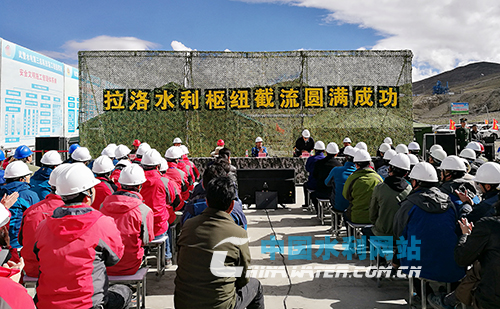
仪式现场

截流现场
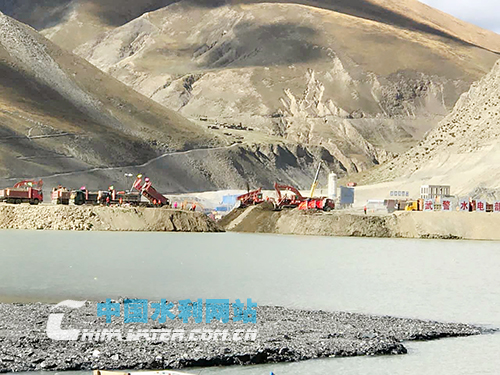
截流成功
Source: Xinhua | 2016-10-01 01:05:13 | Editor: huaxia
LHASA, Sept. 30 (Xinhua) -- Tibet on Friday blocked a tributary of the Yarlung Zangbo River as part of its most expensive hydro project.
The Lalho project on the Xiabuqu River in Xigaze, involves an investment of 4.95 billion yuan (740 million U.S. dollars), said Zhang Yunbao, head of the project's administration bureau.
The project was scheduled to be completed in 2019. Construction began in June 2014.
The project serves multiple purposes, including irrigation, flood control and power generation, said Zhang.
Its reservoir was designed to store up to 295 million cubic meters of water and help irrigate 30,000 hectares of farmland.
The farming area, which usually suffers from severe drought, is a major crop production base in Xigaze.
The project will have two power stations with a combined generation capacity of 42 megawatts. They are designed to generate 85 million kilowatt-hours of electricity each year.

拉洛水利枢纽工程成功截流

仪式现场

截流现场

截流成功
艹艹艹
SENIOR MEMBER

- Joined
- Jul 7, 2016
- Messages
- 5,149
- Reaction score
- 0
- Country
- Location
We must vigorously develop the Yarlung Tsangpo River, cannot be affected by the interference of other countries.Tibet dams river for its costliest hydro project
Source: Xinhua | 2016-10-01 01:05:13 | Editor: huaxia
LHASA, Sept. 30 (Xinhua) -- Tibet on Friday blocked a tributary of the Yarlung Zangbo River as part of its most expensive hydro project.
The Lalho project on the Xiabuqu River in Xigaze, involves an investment of 4.95 billion yuan (740 million U.S. dollars), said Zhang Yunbao, head of the project's administration bureau.
The project was scheduled to be completed in 2019. Construction began in June 2014.
The project serves multiple purposes, including irrigation, flood control and power generation, said Zhang.
Its reservoir was designed to store up to 295 million cubic meters of water and help irrigate 30,000 hectares of farmland.
The farming area, which usually suffers from severe drought, is a major crop production base in Xigaze.
The project will have two power stations with a combined generation capacity of 42 megawatts. They are designed to generate 85 million kilowatt-hours of electricity each year.

拉洛水利枢纽工程成功截流

仪式现场

截流现场

截流成功
ahojunk
RETIRED INTL MOD

- Joined
- Nov 17, 2014
- Messages
- 5,118
- Reaction score
- 6
- Country
- Location
Kazakh herdsmen in Altay move to winter pastures
2016-10-01 11:21 | People's Daily Online | Editor:Li Yan
In the Altay Prefecture of Xinjiang, herdsmen of the Kazakh ethnic group have begun to leave pastures in the deep mountains and move toward winter pastures. (Photo/people.cn)

In the Altay Prefecture of Xinjiang, herdsmen of the Kazakh ethnic group have begun to leave pastures in the deep mountains and move toward winter pastures. (Photo/people.cn)

In the Altay Prefecture of Xinjiang, herdsmen of the Kazakh ethnic group have begun to leave pastures in the deep mountains and move toward winter pastures. (Photo/people.cn)

In the Altay Prefecture of Xinjiang, herdsmen of the Kazakh ethnic group have begun to leave pastures in the deep mountains and move toward winter pastures. (Photo/people.cn)

In the Altay Prefecture of Xinjiang, herdsmen of the Kazakh ethnic group have begun to leave pastures in the deep mountains and move toward winter pastures. (Photo/people.cn)

In the Altay Prefecture of Xinjiang, herdsmen of the Kazakh ethnic group have begun to leave pastures in the deep mountains and move toward winter pastures. (Photo/people.cn)

In the Altay Prefecture of Xinjiang, herdsmen of the Kazakh ethnic group have begun to leave pastures in the deep mountains and move toward winter pastures. (Photo/people.cn)
2016-10-01 11:21 | People's Daily Online | Editor:Li Yan
In the Altay Prefecture of Xinjiang, herdsmen of the Kazakh ethnic group have begun to leave pastures in the deep mountains and move toward winter pastures. (Photo/people.cn)
In the Altay Prefecture of Xinjiang, herdsmen of the Kazakh ethnic group have begun to leave pastures in the deep mountains and move toward winter pastures. (Photo/people.cn)
In the Altay Prefecture of Xinjiang, herdsmen of the Kazakh ethnic group have begun to leave pastures in the deep mountains and move toward winter pastures. (Photo/people.cn)
In the Altay Prefecture of Xinjiang, herdsmen of the Kazakh ethnic group have begun to leave pastures in the deep mountains and move toward winter pastures. (Photo/people.cn)
In the Altay Prefecture of Xinjiang, herdsmen of the Kazakh ethnic group have begun to leave pastures in the deep mountains and move toward winter pastures. (Photo/people.cn)
In the Altay Prefecture of Xinjiang, herdsmen of the Kazakh ethnic group have begun to leave pastures in the deep mountains and move toward winter pastures. (Photo/people.cn)
In the Altay Prefecture of Xinjiang, herdsmen of the Kazakh ethnic group have begun to leave pastures in the deep mountains and move toward winter pastures. (Photo/people.cn)
ahojunk
RETIRED INTL MOD

- Joined
- Nov 17, 2014
- Messages
- 5,118
- Reaction score
- 6
- Country
- Location
The color of autumn in southwest China
2016-09-29 15:20:58 CRIENGLISH.com Web Editor: Fei Fei
What is the color of autumn? It might be difficult to define after seeing the shades of green, yellow and red that Heishui County presents. Heishui is located in southwest China's Sichuan province. [Photo: Chinanews.com]

Autumn colors in Heishui County in Sichuan

Autumn colors in Heishui County in Sichuan

Autumn colors in Heishui County in Sichuan

Autumn colors in Heishui County in Sichuan

Autumn colors in Heishui County in Sichuan

Autumn colors in Heishui County in Sichuan
2016-09-29 15:20:58 CRIENGLISH.com Web Editor: Fei Fei
What is the color of autumn? It might be difficult to define after seeing the shades of green, yellow and red that Heishui County presents. Heishui is located in southwest China's Sichuan province. [Photo: Chinanews.com]
Autumn colors in Heishui County in Sichuan
Autumn colors in Heishui County in Sichuan
Autumn colors in Heishui County in Sichuan
Autumn colors in Heishui County in Sichuan
Autumn colors in Heishui County in Sichuan
Autumn colors in Heishui County in Sichuan
ahojunk
RETIRED INTL MOD

- Joined
- Nov 17, 2014
- Messages
- 5,118
- Reaction score
- 6
- Country
- Location
Covered bridge in China's Chongqing
2016-09-30 17:37:21 Chinanews.cn Web Editor: Shi
Photos taken on Sept. 29, 2016 shows a covered bridge across the Apeng River in southwest China's Chongqing. Those previous wooden buildings covering the bridge were destroyed by fire in 2013, and the bridge reopened one year later after reconstruction. [Photo: Xinhua]

Aerial photo taken on Sept. 29, 2016 shows a covered bridge across the Apeng River in southwest China's Chongqing. Those previous wooden buildings covering the bridge were destroyed by fire in 2013, and the bridge reopened one year later after reconstruction. [Photo: Xinhua]

Aerial photo taken on Sept. 29, 2016 shows a covered bridge across the Apeng River in southwest China's Chongqing. Those previous wooden buildings covering the bridge were destroyed by fire in 2013, and the bridge reopened one year later after reconstruction. [Photo: Xinhua]

Aerial photo taken on Sept. 29, 2016 shows a covered bridge across the Apeng River in southwest China's Chongqing. Those previous wooden buildings covering the bridge were destroyed by fire in 2013, and the bridge reopened one year later after reconstruction. [Photo: Xinhua]

Aerial photo taken on Sept. 29, 2016 shows a covered bridge across the Apeng River in southwest China's Chongqing. Those previous wooden buildings covering the bridge were destroyed by fire in 2013, and the bridge reopened one year later after reconstruction. [Photo: Xinhua]
2016-09-30 17:37:21 Chinanews.cn Web Editor: Shi
Photos taken on Sept. 29, 2016 shows a covered bridge across the Apeng River in southwest China's Chongqing. Those previous wooden buildings covering the bridge were destroyed by fire in 2013, and the bridge reopened one year later after reconstruction. [Photo: Xinhua]
Aerial photo taken on Sept. 29, 2016 shows a covered bridge across the Apeng River in southwest China's Chongqing. Those previous wooden buildings covering the bridge were destroyed by fire in 2013, and the bridge reopened one year later after reconstruction. [Photo: Xinhua]
Aerial photo taken on Sept. 29, 2016 shows a covered bridge across the Apeng River in southwest China's Chongqing. Those previous wooden buildings covering the bridge were destroyed by fire in 2013, and the bridge reopened one year later after reconstruction. [Photo: Xinhua]
Aerial photo taken on Sept. 29, 2016 shows a covered bridge across the Apeng River in southwest China's Chongqing. Those previous wooden buildings covering the bridge were destroyed by fire in 2013, and the bridge reopened one year later after reconstruction. [Photo: Xinhua]
Aerial photo taken on Sept. 29, 2016 shows a covered bridge across the Apeng River in southwest China's Chongqing. Those previous wooden buildings covering the bridge were destroyed by fire in 2013, and the bridge reopened one year later after reconstruction. [Photo: Xinhua]
ahojunk
RETIRED INTL MOD

- Joined
- Nov 17, 2014
- Messages
- 5,118
- Reaction score
- 6
- Country
- Location
Sea of clouds around Jinding Hill, Emei Mountain
Photos show the magnificent sea of clouds surrounding the Jinding Hill of Emei Mountain in Sichuan province.

Jinding Hill of Emei Mountain in Sichuan Province.

Jinding Hill of Emei Mountain in Sichuan Province.

Jinding Hill of Emei Mountain in Sichuan Province.

Jinding Hill of Emei Mountain in Sichuan Province.

Jinding Hill of Emei Mountain in Sichuan Province.

Jinding Hill of Emei Mountain in Sichuan Province.

Jinding Hill of Emei Mountain in Sichuan Province.

Jinding Hill of Emei Mountain in Sichuan Province.
Photos show the magnificent sea of clouds surrounding the Jinding Hill of Emei Mountain in Sichuan province.
Jinding Hill of Emei Mountain in Sichuan Province.
Jinding Hill of Emei Mountain in Sichuan Province.
Jinding Hill of Emei Mountain in Sichuan Province.
Jinding Hill of Emei Mountain in Sichuan Province.
Jinding Hill of Emei Mountain in Sichuan Province.
Jinding Hill of Emei Mountain in Sichuan Province.
Jinding Hill of Emei Mountain in Sichuan Province.
Jinding Hill of Emei Mountain in Sichuan Province.
Similar threads
- Replies
- 0
- Views
- 223
- Replies
- 0
- Views
- 390
- Replies
- 18
- Views
- 1K
- Replies
- 3
- Views
- 298
Latest posts
-
-
-
Pakistani firm wins legal battle against Canadian company at int’l court
- Latest: muhammadhafeezmalik
Pakistan Affairs Latest Posts
-
Pakistani firm wins legal battle against Canadian company at int’l court
- Latest: muhammadhafeezmalik
-
Naya Pakistan to Naya Afghanistani , New Cooking Tools in backward Afghanistan
- Latest: muhammadhafeezmalik



